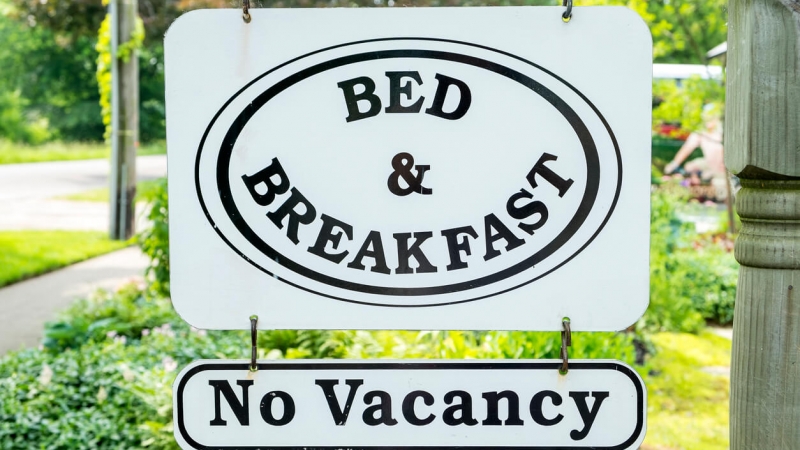There are a few statistics that stay top-of-mind for any hotel manager. Occupancy rate, or the percentage of rooms that are full on any given night, is one of the big ones — and with good reason. Your hotel’s occupancy rate is an indicator of the health of your business, along with revenue per available room (RevPAR), and overall profitability. There will of course be seasonal and event-based fluctuations in demand, but keeping your hotel as full as possible will ensure that you have money coming in through both high and low seasons. Want to learn how to increase hotel occupancy with proven strategies and techniques? Keep reading!
What is your hotel’s occupancy rate?
You’ll need a good understanding of your baseline occupancy rate and how it changes throughout the year before you can start improving your rates. Your hotel’s occupancy rate is the number of occupied sleeping rooms divided by the number of available sleeping rooms. This can be calculated by day, week, month, or even longer, and can be compared to other similar hotels in your area to give you an idea of how you stack up against your competition.
Looking at occupancy rates can give you a good idea of demand at your hotel, indicating which days of the week and times of the year you're likely to see the highest demand for rooms. This can help you determine your pricing strategy, know when to promote special packages, and help with revenue management.
It may seem like offering discounts during low periods is a surefire way to increase hotel occupancy, but this isn’t always the case. Discounts may help convert potential customers who are already thinking about traveling, but they do nothing to increase demand for travel itself. For that, you’ll need creative strategies to increase value.
Explore 9 strategies to help increase hotel occupancy:
1. Adjust your marketing for periods of low demand.
One of the first things strategists tell you when you mention a low occupancy rate is to adjust your marketing. But that type of vague advice won’t bring guests in the door. Your hotel marketing strategy for periods of low occupancy needs to be detailed and specific.
If you’re seeing a drop in mid-week demand, you need to target the types of guests that engage in weekday travel. This includes business travelers, out-of-town travelers viewing real estate, trade show and conference attendees, retirees looking for deals, and so on. Consider which of these groups match well with your hotel’s amenities, location, and brand presence, and then come up with a plan to add value for each of those guest types.
In terms of seasonal demand, think about what makes your property and your location stand out during the off-season. For example, if you run a ski resort that has low occupancy in the summer months, think about what summer activities your guests might be interested in. You can then focus on that messaging when reaching out to guests who have previously visited in the winter.
You can also increase your upsell marketing to focus on guests who have already booked with you. You may be able to entice weekend guests to stay until mid-week, summer guests to add a few days of shoulder season, and overnight guests to stay for a week with the right value and packages.
2. Increase value with specials and packages.
Throughout the year, you can increase the value of your property by introducing specials and packages. These work better than discounts for increasing demand, as they include something extra for the same price and can help you stand out from the competition.
One popular way of adding value to your packages is to bundle various services and amenities together. If you have an on-site spa and restaurant, add a spa lunch and massage for guests who stay for three days mid-week. For guests visiting a beach location in the winter, throw in a branded throw blanket and a warming cocktail at your bar. Tailor your packages to the occupancy period and the guest type to get the highest return on your investment.
3. Invest in guest services and staff training.
If you notice that your occupancy rates are lower than your competition, seasonality and demand may be less important than your reputation. No matter the time of year, hotels with the best guest and planner experiences will almost always come out on top. By investing in staff training and guest services programs, you can impress guests and ensure that a good portion of the travelers to your area will choose to stay at your property.
Educate your staff about the different types of guests your property is targeting, and how they can create great experiences. Work with your sales and marketing teams to understand guest motivations and priorities, and clearly communicate that information to guest-facing team members.
4. Add in-demand amenities.
Hotel amenities go through fluctuations in demand just like locations do. Take a look at your utilization rates for the different amenities you offer so that you can understand how demand for your amenities changes over time. Double down on high-demand amenities in your sales and marketing communications, and consider special packages promoting the lower demand amenities to guests.
If you notice that guests are asking for certain amenities a lot, either in your hotel’s reviews or in reviews for other area properties, consider adjusting your offerings. For example, if a lot of reviews in the area mention a lack of highchairs and cribs, you can capture a new audience segment by being the hotel that caters to travelers with kids. By listening to what your guests want, you’ll find ways to increase demand and, in turn, increase hotel occupancy.
5. Focus on repeat guests.
Guests and planners who have chosen your hotel in the past — particularly those who had a positive experience — are much easier to market to than ones who have never heard of you. Take the time to build email lists for each audience segment so you know when to reach out to that group with specific promotions.
Remarketing ads are shown to people who have visited your website, viewed social media content, stayed at your property, or joined your email list in the past. These are powerful tools to reach people who already have an interest in your property. For example, you can serve ads to guests who have visited in your high season with your latest packages so they can see what your location is like in the low season as well.
Your loyalty program is also an important piece of the puzzle for repeat customers. Make sure the program is personalized, rewarding, and treats guests like the valuable customers they are. You may even want to add specific loyalty packages for repeat guests who stay with you during periods of low occupancy.
6. Work with a revenue manager.
A professional revenue manager can turn the tide on low occupancy rates, helping you reach the right guests with the right offers at the right time. Revenue managers use historical hotel data to forecast future demand and recommend actions to increase revenue. Their focus is less on occupancy rates themselves, and more about how those rates fit into a larger picture of your hotel’s revenue.
Revenue management used to be solely focused on reacting to the past, but technology has changed the game in recent years. Automated systems can now show managers how they're performing across market segments, channels, and properties on a daily basis. This huge amount of data, and the business intelligence that comes with it, gives hotel revenue managers the ability to understand which customers to target and when.
7. Manage your online reputation.
Your reputation online, including reviews, search results, social media posts, local press, awards, and photos from corporate events, play a major role in guests deciding where to stay. Much of your online reputation is out of your control, but there are a few things you can do to engage with guests online and ensure that they see you in a positive light.
For starters, respond to all negative feedback online in a timely manner, offering constructive steps forward and personalized communication with guests. You can listen for negative reviews using social listening software with alerts set for your hotel and brand name.
Combat negative information by posting frequent social media updates, highlighting positive guest experiences, and engaging with influencers. Showcase top corporate events, recent updates to your hotel, and great team members on your website, social media, and through partnerships with bloggers. By improving your hotel's reputation online, you’ll be more likely to increase occupancy and maintain target rates during periods of low demand.
8. Think location, not property.
Sometimes a shift in focus can be the key to improving your hotel's occupancy. Think beyond your individual property to the wider location, and you may come up with some great ideas for growth. Engage with your local CVB or DMO to see how they're drawing travelers to your location, and how you can partner with them to market specific activities or amenities. Speak with local businesses to see if you can collaborate on events, feature their products in guest welcome baskets, or create co-branded experiences.
9. Create engaging events for specific audiences.
Events are great for drawing in a crowd, and the right event can result in a substantial increase in both demand and occupancy. But events should never be one size fits all. Think back to the target groups and the marketing you're already doing to reach them. Is there an event that fits in with the marketing strategy for each group? For example, if you’ve decided to target retirees for mid-week travel, can you hold an event where a local author speaks about financial planning in retirement? Or can you target house hunters by teaming up with a local real estate agent who can offer home buying tips?
By creating targeted events for specific audiences, you can measure their impact on occupancy rates by segment and make sure that you’re getting a good return on your investment. You’ll also develop a positive reputation with a new segment of guests, fueling other strategies like mailing list outreach, repeat guest promotions, and adding value through special packages.
Combine these strategies to increase hotel occupancy and boost business!
Up next, maximize your visibility with these 7 hotel content marketing tips.









